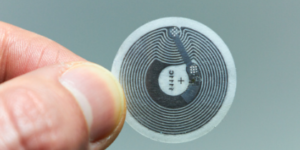Retailers rely on RFID for inventory tracking and omnichannel enablement. As the technology becomes more affordable and scalable, retailers realise a higher ROI on their investment. RFID technology enables stores to track product movement in physical space.
RFID allows retailers to lower cycle count time, automate reordering at safety stock levels and more. Learn more about how this solution can help your business below. For more RFID-enabled retail, check this out.
Inventory Tracking
 The most apparent benefit of deploying RFID is improving inventory accuracy and management. It reduces costs, improves customer service, and increases revenue.
The most apparent benefit of deploying RFID is improving inventory accuracy and management. It reduces costs, improves customer service, and increases revenue.
For retailers with a high volume of online, pickup in-store orders, it’s essential to have accurate inventory counts for every store location. It helps provide a smooth pickup experience for customers and eliminates lost sales.
With a simple mobile app, a retail employee can take a wireless inventory count in minutes without needing line-of-sight. The count is automatically pushed back into the POS or ERP system with a push of a button. It also makes it easy to automate reorders at safety stock levels. Streamlined processes reduce labour costs and increase productivity. A single employee can scan an entire aisle of merchandise in seconds and at a higher speed than traditional barcode scanning.
Inventory Accuracy
With the ability to instantly check in entire shipments, rather than relying on individual package scanning and blind receipts, RFID improves inventory accuracy by eliminating mistakes, reducing cycle count time and automatically reordering items at safety stock levels. It improves overall inventory accuracy by a significant margin and helps retailers avoid costly out-of-stock and missed sales opportunities. For more RFID-enabled retail, check this out.
When it comes to delivering on customer expectations of buy-online-pickup-in-store and ship-from-store, high inventory accuracy is a must-have capability for retail brands. In addition to enabling those capabilities, RFID improves store operations by simplifying inventory management.
By reducing cycle count time, removing formal inventory counts and auto-reordering at safety stock levels, RFID allows retailers to get their products on the floor quickly and reduce their backroom costs by as much as 20%.
Inventory Reliability
The ability to track inventory throughout a store is crucial to retailers. In some environments, this is as simple as pinpointing where an item is in the store. For a wedding dress retailer, for example, that means knowing the exact floor location of a gown so it can be easily found.
RFID can improve in-store inventory accuracy to 98%, approaching warehouse levels. Each inaccurately inventoried item represents a missed sales opportunity.
Streamlined checkouts and buy online, pickup in-store customer service require reliable and accurate inventory management. With RFID, this is possible without sacrificing customer experience.
Security
An RFID tag contains readable digital data. Criminals who know how to read that data can steal items. It is called digital pickpocketing.
RFID can work with EAS systems to prevent theft at the point of sale. It has a lower false-alarm rate and costs less than traditional EAS tags.
Modern RFID retail systems can also give retailers real-time inventory visibility from manufacturing to distribution centres, stores, and shoppers. It helps to reduce inventory shrink and optimise supply chain operations.
Smart shelves can detect when products are getting low in stock, which means no more missed sales opportunities. The RFID system will send an alert to store associates to restock shelves.
Customer Experience
RFID technology provides real-time item tracking that helps to optimise omnichannel fulfilment trends such as buying online and picking up in-store (BOPIS). For example, major retailers often require vendors and manufacturers to tag items on initial inbound shipments, which helps to ensure optimal inventory accuracy throughout the supply chain and for customers at stores.
In addition, RFID technology enables stores to track product movement in physical space. For example, at computer vision-based checkout-free stores, an RFID-enabled mirror in the fitting room can respond to proximity triggers to help shoppers with outfitting and styling decisions.
As the world works towards the “next normal” and beyond, retailers must look ahead and plan for permanent changes to consumer shopping habits and expectations.






Comments are closed, but trackbacks and pingbacks are open.